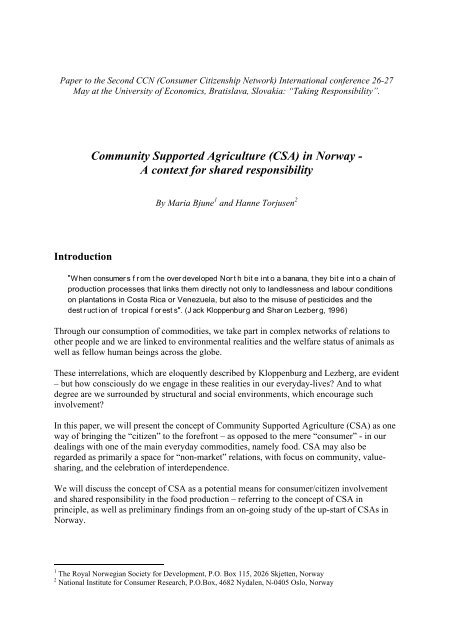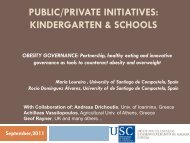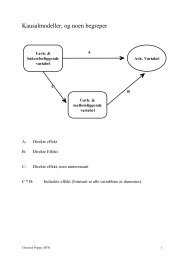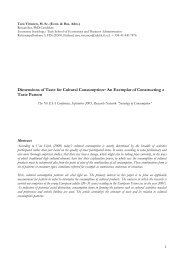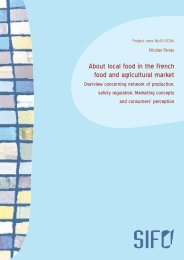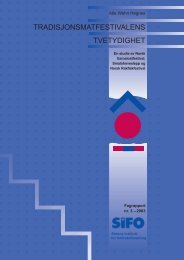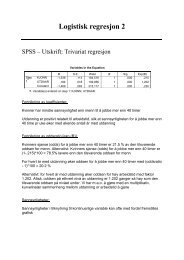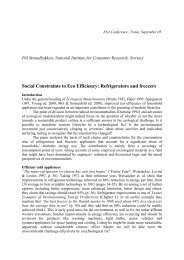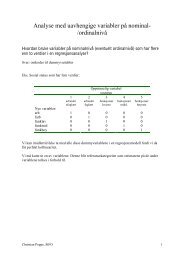Community Supported Agriculture (CSA) in Norway - A ... - SIFO
Community Supported Agriculture (CSA) in Norway - A ... - SIFO
Community Supported Agriculture (CSA) in Norway - A ... - SIFO
- No tags were found...
Create successful ePaper yourself
Turn your PDF publications into a flip-book with our unique Google optimized e-Paper software.
Paper to the Second CCN (Consumer Citizenship Network) International conference 26-27May at the University of Economics, Bratislava, Slovakia: Tak<strong>in</strong>g Responsibility .<strong>Community</strong> <strong>Supported</strong> <strong>Agriculture</strong> (<strong>CSA</strong>) <strong>in</strong> <strong>Norway</strong> -A context for shared responsibilityBy Maria Bjune 1 and Hanne Torjusen 2IntroductionWhen consumer s f r om t he over developed Nor t h bit e <strong>in</strong>t o a banana, t hey bit e <strong>in</strong>t o a cha<strong>in</strong> ofproduction processes that l<strong>in</strong>ks them directly not only to landlessness and labour conditionson plantations <strong>in</strong> Costa Rica or Venezuela, but also to the misuse of pesticides and thedest r uct ion of t r opical f or est s . (J ack Kloppenbur g and Shar on Lezber g, 1996)Through our consumption of commodities, we take part <strong>in</strong> complex networks of relations toother people and we are l<strong>in</strong>ked to environmental realities and the welfare status of animals aswell as fellow human be<strong>in</strong>gs across the globe.These <strong>in</strong>terrelations, which are eloquently described by Kloppenburg and Lezberg, are evidentbut how consciously do we engage <strong>in</strong> these realities <strong>in</strong> our everyday-lives? And to whatdegree are we surrounded by structural and social environments, which encourage such<strong>in</strong>volvement?In this paper, we will present the concept of <strong>Community</strong> <strong>Supported</strong> <strong>Agriculture</strong> (<strong>CSA</strong>) as oneway of br<strong>in</strong>g<strong>in</strong>g the citizen to the forefront as opposed to the mere consumer - <strong>in</strong> ourdeal<strong>in</strong>gs with one of the ma<strong>in</strong> everyday commodities, namely food. <strong>CSA</strong> may also beregarded as primarily a space for non-market relations, with focus on community, valueshar<strong>in</strong>g,and the celebration of <strong>in</strong>terdependence.We will discuss the concept of <strong>CSA</strong> as a potential means for consumer/citizen <strong>in</strong>volvementand shared responsibility <strong>in</strong> the food production referr<strong>in</strong>g to the concept of <strong>CSA</strong> <strong>in</strong>pr<strong>in</strong>ciple, as well as prelim<strong>in</strong>ary f<strong>in</strong>d<strong>in</strong>gs from an on-go<strong>in</strong>g study of the up-start of <strong>CSA</strong>s <strong>in</strong><strong>Norway</strong>.1The Royal Norwegian Society for Development, P.O. Box 115, 2026 Skjetten, <strong>Norway</strong>2 National Institute for Consumer Research, P.O.Box, 4682 Nydalen, N-0405 Oslo, <strong>Norway</strong>
1.4. What do shareholders pay for?At our recent sem<strong>in</strong>ar for the <strong>CSA</strong> pilot-farms 8 , an <strong>in</strong>terest<strong>in</strong>g discussion from Buschberghof<strong>CSA</strong> <strong>in</strong> Germany was referred by Wolfgang Stränz. The issue at stake was whether or notvegetarians should pay less than meat-eaters because they did not use any meat. From aproduct-po<strong>in</strong>t of view, this was of course true, but from other perspectives, the case mightlook differently. From a diet-po<strong>in</strong>t of view, the vegetarians did get their full diet covered <strong>in</strong> anequal manner as the meat-eaters. And from a po<strong>in</strong>t of view that the shareholders are pay<strong>in</strong>gfor the ma<strong>in</strong>tenance of the farm<strong>in</strong>g activity as such (they are passive farmers), it is beside thepo<strong>in</strong>t what particular products they get from it. Another po<strong>in</strong>t is the <strong>in</strong>terconnectedness(particularly <strong>in</strong> organic agriculture) between crop production and animal husbandry: also thecarrots have been produced with the application of manure.By the formulation we are all farmers , Stränz implicates that tak<strong>in</strong>g (co-) responsibility fora particular piece of land and the ma<strong>in</strong>tenance of a sound food production (on that site)qualifies for us<strong>in</strong>g the term. The active farmers are <strong>in</strong>volved with the physical labour and takethe agronomic responsibility, while the passive farmers contribute economically by buy<strong>in</strong>g ashare. And then they don t count their carrots or litres of milk afterwards.At our <strong>CSA</strong> pilot-farms, there are some specific examples of common goods which couldbe regarded as worth pay<strong>in</strong>g for <strong>in</strong> a similarly unspecific way:1. At the urban farm close to Oslo, the issue of land protection has been on the agenda.Recently, surround<strong>in</strong>g farm<strong>in</strong>g areas have been converted <strong>in</strong>to golf courses, andseveral of the citizens <strong>in</strong> the neighbourhood would rather keep these areas for foodproduction and keep<strong>in</strong>g them accessible as traditional cultural landscapes.2. At one of the rural <strong>CSA</strong>, with cooperation between three organic farms, <strong>in</strong> situprotection and ma<strong>in</strong>tenance of gra<strong>in</strong> genetic resources is highly relevant. At one of thefarms, there is production and research on rare varieties of gra<strong>in</strong>, traditional to theNordic region. Mak<strong>in</strong>g use of bak<strong>in</strong>g facilities at another of the farms <strong>in</strong>volved, thereare plans for the development of particular recipes and bak<strong>in</strong>g of breads etc. with thesespecial types of gra<strong>in</strong>. Bread is a type of commodity with potentially a very long andcomplex cha<strong>in</strong>, and where the orig<strong>in</strong>s of the gra<strong>in</strong>, as well as <strong>in</strong>formation about thegenetic variety may be obscured for the end-consumer. At the same time, the issue ofsecur<strong>in</strong>g genetic diversity is very much on the agenda. Membership and responsibilityfor local food production might be a nice supplement to sign<strong>in</strong>g up for sav<strong>in</strong>g the ra<strong>in</strong>forest.3. And as a more general concern, the offer of organic food <strong>in</strong> the general food market <strong>in</strong><strong>Norway</strong> does not seem to satisfy the demand (neither <strong>in</strong> terms of volume nor <strong>in</strong> termsof product variety). In this regard, be<strong>in</strong>g a shareholder <strong>in</strong> any of the <strong>CSA</strong>s currentlystart<strong>in</strong>g up means secur<strong>in</strong>g the production of organic food and even be<strong>in</strong>g given anopportunity to have a say <strong>in</strong> the types of food be<strong>in</strong>g produced.8 Fokhol Farm, February 16th2004, sem<strong>in</strong>ar about <strong>Community</strong> <strong>Supported</strong> <strong>Agriculture</strong>.4
2. The <strong>CSA</strong> project <strong>in</strong> <strong>Norway</strong>Somet h<strong>in</strong>g has t o be changedThe Leopar d )otherwise ever yt h<strong>in</strong>g will be changed (Guiseppe di Lampedusa <strong>in</strong>2.1. Relevant backgroundThe government give clear signals towards a more consumer oriented agriculture <strong>in</strong> thefuture. All l<strong>in</strong>ks from farm to fork is responsible for improved <strong>in</strong>formation about products andproduction. More and more consumers want <strong>in</strong>formation about the orig<strong>in</strong> of their food, andthe consciousness of different ethical aspects, environmental aspects as well as regionalism isslowly <strong>in</strong>creas<strong>in</strong>g.A political aim is to <strong>in</strong>crease the organically grown land from about 4% today to 10% <strong>in</strong>2009. The ma<strong>in</strong> obstacle for this goal is the market situation. The process<strong>in</strong>g units, as well asretailers, are concentrated to a handful of companies, and their structure is not at all adapted tosmall product-groups. The path from farm and fork is thorny for small products like organicor regional specialities. In 2004, about 80% of the organic milk produced <strong>in</strong> <strong>Norway</strong> was soldas conventional. The number for organic meat was about 90%.The Royal Norwegian Society for Development received economic support from the M<strong>in</strong>istryof Food and <strong>Agriculture</strong>, to develop examples of <strong>CSA</strong>s adapted to the Norwegian reality(Bjune 2003). The project is implemented <strong>in</strong> close cooperation with National Institute forConsumer Research. Two organizations promot<strong>in</strong>g organic products and production are also<strong>in</strong>cluded <strong>in</strong> the project, - i.e. Oikos and Grønn Hverdag.2.2. Products; From multifunctional agriculture?Most <strong>CSA</strong>-farms focus on vegetables, and present a long list of different vegetables and freshsalads delivered all year. We started to study <strong>CSA</strong> <strong>in</strong> early 2003, with the cold and snowoutside and imported organic vegetables on the table <strong>in</strong>side. Examples from USA show<strong>in</strong>g 46different k<strong>in</strong>ds of vegetables delivered from the local <strong>CSA</strong>-farm 8 months pr. year almostkilled our enthusiasm, and hence the cont<strong>in</strong>uation of the project. We had to th<strong>in</strong>k differentlyabout the product range.Due to trade agreements with WTO and EU, the border is slowly open<strong>in</strong>g up for import.Hence the need is def<strong>in</strong>itely not food products with standard quality, compet<strong>in</strong>g on low price.High cost agriculture, like the Norwegian, must compete on quality and not quantity. One ofthe qualities might be closeness to and knowledge about a clean production.The relevant questions were:1. What do modern people need from the Norwegian agriculture?2. What products, services and activities can Norwegian agriculture offer, withoutloos<strong>in</strong>g the competition with import products from countries with lower productioncosts?3. Are there anybody out there who prefer locally produced products, and pay the priceof local costs?5
<strong>CSA</strong> can be seen as one possible alternative to the WTO-policy: It provides local argumentsfor a local agriculture. And the cost of this agriculture is transparent to the shareholder.2.3. Three pilot-<strong>CSA</strong>s2.3.1. Øverland farmThe farm is located <strong>in</strong> the outskirt of Oslo towards the best west . It is a po<strong>in</strong>t of departurefor hikes and ski<strong>in</strong>g <strong>in</strong>to the surround<strong>in</strong>g forest area. The farm is owned by Norges Vel, - theorganization runn<strong>in</strong>g this project. One problem is that the present production is dom<strong>in</strong>ated bymonoculture of gra<strong>in</strong>, - it will take some time to achieve a manifold <strong>in</strong> the product spectre.The potential is substantial. In this <strong>CSA</strong>, there is a special opportunity for extended learn<strong>in</strong>gactivities by cooperation with two local schools. Their first season is well <strong>in</strong> progress, and aparticular part of the <strong>CSA</strong>-farm is devoted to a school garden. The curriculum refers to thefarm as the extended classroom .2.3.2. Solør two farmsSolør is a region located 2,5 -3 hours drive NE of Oslo, <strong>in</strong> a very scarcely populated area.There are two family farms already cooperat<strong>in</strong>g about mach<strong>in</strong>ery and market<strong>in</strong>g, and theywant to extend their cooperation <strong>in</strong>to a <strong>CSA</strong>. Together they have a wide range of organicproducts like vegetables, different k<strong>in</strong>ds of meat, gra<strong>in</strong>, as well as forest products, hunt<strong>in</strong>g andfish<strong>in</strong>g. One of the farms is <strong>in</strong>volved with social work as well, offer<strong>in</strong>g work for people withspecial needs.2.3.3. Hadeland/R<strong>in</strong>gerike three farmsThis is situated about one hour NW of Oslo <strong>in</strong> a middle populated area. Two family farmsand one farm owned by a trust do<strong>in</strong>g social work want to cooperate. Together they offer awide range of products, like Solør.2.4. Models for organizationOne level is to organize the cooperation between the farms with<strong>in</strong> one <strong>CSA</strong>. Another level isto organize the cooperation between the farm(s) and the consumers. The latter is the most<strong>in</strong>terest<strong>in</strong>g here, and there are many alternatives; There are examples of trusts, different k<strong>in</strong>dsof companies with limited responsibility, or simply a looser association. This is partly aquestion of attitudes and ideals, and partly a question of more pragmatic legal adaptations.3. How can <strong>CSA</strong> contribute to consumer responsibility?We ar e all f ar mer s act ive or passive , (W. Stränz, member of Buschberghof <strong>CSA</strong>, Germany).3.1. Shar<strong>in</strong>g of responsibility and rewards<strong>CSA</strong> is based on the idea of cooperative ownership to the production, but not necessarily thefarm. Consumers share the responsibility for the production by buy<strong>in</strong>g shares <strong>in</strong> theproduction for one year ahead, participate <strong>in</strong> the plann<strong>in</strong>g of the season, and <strong>in</strong> most casesthey pay part of the cost <strong>in</strong> advance. In this way the consumers very directly share the risk andrewards of any agronomic and climatic variation of the produce.6
3.2. Alternative to global world marketCitizens may choose to buy food through local alternatives to the global conventional foodsystem. <strong>CSA</strong> is such an alternative. Examples of the concerns one may address whenchoos<strong>in</strong>g organic foods from the local community are the problems related to theenvironmental costs which are often externalised <strong>in</strong> the conventional food production.Calculations estimate that food <strong>in</strong> the United States travels an average of more than 2 000kilometres 9 before it reaches the end-consumer, and that food process<strong>in</strong>g, packag<strong>in</strong>g,transportation, and market<strong>in</strong>g accounts for approximately 75 to 85 per cent of the energyconsumed <strong>in</strong> the food system 10 (Hendrickson et al. 1995). There is reason to believe that thesituation is similar <strong>in</strong> Europe. In a recent calculation of the environmental costs of the UKfood basket, the authors concluded that it is clear that actions to reduce farm and food mileexternalities, and shift consumers decisions on specific shopp<strong>in</strong>g preferences and transportchoices would have a substantial impact on environmental outcomes (Pretty et al. 2005).In order to share responsibility <strong>in</strong> the consumer role, <strong>in</strong>formation, <strong>in</strong>sight and knowledge isimperative. Several researchers have po<strong>in</strong>ted out that the distance and complexity <strong>in</strong> the foodsystem is a severe challenge <strong>in</strong> relation to tak<strong>in</strong>g responsibility as a consumer/citizen. JackKloppenburg and Sharon Lezberg are among them:How can we act responsibly and effectively for change if we do not understand how the foodsystem works and our role with<strong>in</strong> it? (Kloppenburg and Lezberg 1996)From this perspective, distance is a problem <strong>in</strong> terms of citizen <strong>in</strong>volvement <strong>in</strong> how our foodis produced. Several aspects of distance come <strong>in</strong>to play - both <strong>in</strong> terms of spatial distance,temporal distance, and distance of m<strong>in</strong>d (Lieble<strong>in</strong> et al. 2001). It is by means of provid<strong>in</strong>g analternative to such situations characterised by distance, formalised systems of <strong>in</strong>formation,and trust <strong>in</strong> abstract systems that <strong>CSA</strong>s may offer a qualitatively different context for foodprovision<strong>in</strong>g and community build<strong>in</strong>g. Follow<strong>in</strong>g the American author and ecologist WendellBerry (1992), we agree that direct experience is a powerful way to <strong>in</strong>volvement and care.Here is his advice about how to eat responsibly :Learn as much as you can, by direct observation and experience if possible, of the lifehistories of the food species .He further elaborates on the connections he sees between the enjoyments of the food productsas such, and the <strong>in</strong>sight <strong>in</strong>to the history beh<strong>in</strong>d the food:The pleasure of eat<strong>in</strong>g should be an extensive pleasure, not that of the mere gourmet. ( )The knowledge of the good health of the garden relieves and frees and comforts the eater. Thesame goes for eat<strong>in</strong>g meat. The thought of the good pasture and of the calf contentedlygraz<strong>in</strong>g flavors the steak. ( ) A significant part of the pleasure of eat<strong>in</strong>g is <strong>in</strong> one s accurateconsciousness of the lives and the world from which food comes. The pleasure of eat<strong>in</strong>g, then,may be the best available standard of our health. (Berry 1992; 378).91 300 miles (2 092 km). The Packer 1992 referred <strong>in</strong> Hendrickson et al. 199510Hendrickson, J. (1995) Energy Use <strong>in</strong> the Food System , Presentation given at Regional Food SystemsSem<strong>in</strong>ar, Centre for Integrated Agricultural Systems, University of Woscons<strong>in</strong>-Madison, referred <strong>in</strong> Hendricksonet al. 1995.7
Small-scale, alternative or direct systems have quite different character:- The producer is personally accountable and trust is placed <strong>in</strong> particular people- Transparency and traceability are high, and communication often takes place face-toface- Products are not standardised, often not packaged, and sometimes not labelled- Customer service is given high priority <strong>in</strong> this k<strong>in</strong>d of market<strong>in</strong>g sett<strong>in</strong>g- Supplies are highly dependant on locality and season, and sometimes supplemented bynon-local, non-seasonal supplies- Feedback from consumers is provided <strong>in</strong> the form of personal communicationCommunication <strong>in</strong> this system is ma<strong>in</strong>ly limited by the time available for exchange of<strong>in</strong>formation, which is likely to be highly variable. In pr<strong>in</strong>ciple, however, the consumer is freeto ask any number of questions, while the salesperson is offered the advantage of be<strong>in</strong>g ableto obta<strong>in</strong> first hand <strong>in</strong>formation about consumer requirements, preferences, wishes andconcerns. In cases <strong>in</strong> which farmers and growers take on the role of sales personnel,experience-based expert <strong>in</strong>formation is available, but all such systems tend to offer some levelof expertise as part of their customer service.In this broad outl<strong>in</strong>e of the polarities between the global and the local, we f<strong>in</strong>d the concept of<strong>CSA</strong> to be a prime example of a personalised direct, market<strong>in</strong>g channel. <strong>CSA</strong>s may provide acontext where people can get to know real stories about real people . This is what DanielMiller (2003) set out to br<strong>in</strong>g to school-children <strong>in</strong> his project concern<strong>in</strong>g the <strong>in</strong>ternet as ameans to de-fetishis<strong>in</strong>g commodities.For commodities that are produced far away, such as cocoa or bananas, the <strong>in</strong>ternet may be anexcellent means of establish<strong>in</strong>g direct contact between producers and consumers as well asto all the other people <strong>in</strong>volved along the cha<strong>in</strong> (such as managers, packers, transporters,planners etc.). Such contact is meant as a process of personalisation, where the commoditybecomes the personalised objectification of the relationships that it creates (Miller2003,10). But many of the goods that we consume may very well be produced <strong>in</strong> our moreimmediate environment, among them many of the basic food products <strong>in</strong> our diet. And forthese k<strong>in</strong>ds of products, <strong>CSA</strong> may be an excellent way of bond<strong>in</strong>g with the people beh<strong>in</strong>d theproducts.A comb<strong>in</strong>ation of the direct and personal <strong>CSA</strong>-relations with people nearby and contact overthe <strong>in</strong>ternet with distant people with whom we also have food relations would be very<strong>in</strong>terest<strong>in</strong>g to try out. There are many ways <strong>in</strong> which such contact would make sense with<strong>in</strong>the <strong>CSA</strong>-concept. For example, contact could very well be made with producers of <strong>in</strong>putfactors to the farm, such as producers of <strong>in</strong>gredients to animal fodder, or raisers of younganimals (such as chicken), or with people who provide other commodities that those whichcan be produced at a local farm (such as bananas, citrus fruits, tea, coffee).3.4. Conclud<strong>in</strong>g remarksStevenson (1998) has suggested the term food citizenship to grasp the way we mayparticipate consciously with<strong>in</strong> the food system as eaters and citizens, and we f<strong>in</strong>d this termto be useful <strong>in</strong> explor<strong>in</strong>g the potentials of <strong>CSA</strong>. Stevenson uses the notion of competencies,and explores what he sees as important dimensions of a human <strong>in</strong>frastructure for negotiat<strong>in</strong>galternative agrifood systems . He f<strong>in</strong>ds these key competencies to <strong>in</strong>clude analytical9
competencies (of mak<strong>in</strong>g connections and evaluat<strong>in</strong>g contradictions), relational competencies(focuss<strong>in</strong>g on new forms of food citizenship <strong>in</strong>volv<strong>in</strong>g alternative organizational relationshipsbetween actors <strong>in</strong> the food cha<strong>in</strong>), ethical competencies (<strong>in</strong>clud<strong>in</strong>g the valu<strong>in</strong>g of non-marketgoods and the l<strong>in</strong>kages between ethics and emotions), and f<strong>in</strong>ally, aesthetic and spiritualcompetencies to connect agriculture and food with beauty and with what he calls sacramentalliv<strong>in</strong>g (Stevenson 1998).All the different types of competencies mentioned above may potentially be alluded to <strong>in</strong> a<strong>CSA</strong> context. By offer<strong>in</strong>g a rich variety of learn<strong>in</strong>g opportunities and a broad range of ways ofexperienc<strong>in</strong>g and learn<strong>in</strong>g about food both through direct experience, and through mak<strong>in</strong>g<strong>in</strong>formation about the food available, we believe the concept of <strong>CSA</strong> may offer an opportunityfor food citizenship and shar<strong>in</strong>g of responsibility.LiteratureBerry, Wendell (1992) The Pleasures of Eat<strong>in</strong>g. In: Curt<strong>in</strong>, D. W. and Heldke, L. M. (eds.)Cook<strong>in</strong>g, eat<strong>in</strong>g, th<strong>in</strong>k<strong>in</strong>g. Transformative philosophies of food. Bloom<strong>in</strong>gton andIndianapolis: Indiana University Press, pp. 374-379.Bjune, M. (2003) <strong>Community</strong> <strong>Supported</strong> <strong>Agriculture</strong> tilpasn<strong>in</strong>g til norske forhold. Reportfrom feasibility-study, March 2003. Norges Vel report no. 2/2003.Cone, C. A. and Kakaliouras, A. (1995). <strong>Community</strong> <strong>Supported</strong> <strong>Agriculture</strong>: Build<strong>in</strong>g Moral<strong>Community</strong> or an Alternative Consumer Choice. Culture and <strong>Agriculture</strong>, 51/52: 28-31.DeL<strong>in</strong>d, L. B. (1999). Close encounters with a <strong>CSA</strong>: The reflections of a bruised andsomewhat wiser anthropologist. <strong>Agriculture</strong> and Human Values, 16:3-9.Donahue, T. P. (1994). <strong>Community</strong>-<strong>Supported</strong> <strong>Agriculture</strong>: Opportunities for EnvironmentalEducation. Journal of Education, 25(2): 4-8-Fieldhouse, P. (1996). <strong>Community</strong> Shared <strong>Agriculture</strong>. <strong>Agriculture</strong> and Human Values,13(3):43-47.Henderson, E. (1999). Shar<strong>in</strong>g the Harvest. A guide to <strong>Community</strong> <strong>Supported</strong> <strong>Agriculture</strong>.White River Junction, Vermont: Chelsea Green Publish<strong>in</strong>g Company.Hendrickson, J., Hart, L., Gale-S<strong>in</strong>ex, M., Stevenson, S. (1995). Regional Food SystemsResearch: Needs, Priorities, and Recommendations. University of Wiscons<strong>in</strong>-Madison,Centre for Integrated Agricultural Systems.Kloppenburg, J. Jr. and Lezberg, S. (1996). Gett<strong>in</strong>g it Straight Before We Eat Ourselves toDeath: From Food Systems to Foodshed <strong>in</strong> the 21 st Century. Society & Natural Resources,9:93-96.Lieble<strong>in</strong>, G., Francis, C. A., and Torjusen, H. (2001). Future Interconnections AmongEcological Farmers, Processors, Marketers, and Consumers <strong>in</strong> Hedmark County, <strong>Norway</strong>:Creat<strong>in</strong>g Shared Vision. Human Ecology Review, 8(1):60-71.10
Miller, D. (2003). Could the Internet defetishise the commodity? Environment and Plann<strong>in</strong>gD: Society and Space, 23:Pretty, J. N., Balla, A. S., Langb, T. and Morisona, J. I. L. (2005) Farm costs and food miles:An assessment of the full cost of the UK weekly food basket. Food Policy, 30(1):1-19.Soil Association (year not given): A share <strong>in</strong> the harvest<strong>Supported</strong> <strong>Agriculture</strong>.An action manual for <strong>Community</strong>Stevenson, G. W. (1998). Agrifood systems for competent, ord<strong>in</strong>ary people. <strong>Agriculture</strong> andHuman Values 15, 199-207.Torjusen, H., Kjærnes, U. and O Doherty Jensen, K. (2005). Social and Ethical Aspects. In:L. Lück & K. Brandt (eds.): Organic Food Production: Safety and Quality Assurance.Oxford: Blackwell (forthcom<strong>in</strong>g 2005).11
This document was created with W<strong>in</strong>2PDF available at http://www.daneprairie.com.The unregistered version of W<strong>in</strong>2PDF is for evaluation or non-commercial use only.


